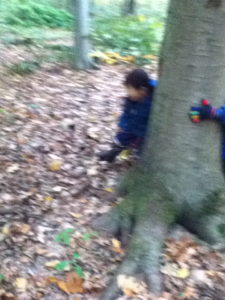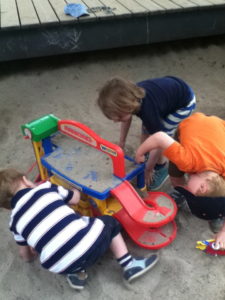The Slide Ruler.
In addition to the introduction of the modern library and the pencil during the 1600s, the Slide Rule was first introduced in 1654 by Robert Bissaker. The instrument was designed for use by scientists and engineers up to the early 1970s.
The Hornbook.
During the 1600s, the hornbook was used in the classroom as a technology device that taught basics such as vowels and consonants as well as the alphabet.
The Magic Lantern.
The magic lantern was first introduced in 1646 and was also known as the Magin Catacoprica which meant “magic lantern.” Although the device was used in homes and theaters, magic lanterns were deployed in the classroom to enhance learning and student engagement.
Slates and Chalk.
It was during the 1800s that students used slates which were small blackboards that were written on using a piece of chalk. Students used slates in place of pen and paper, even though slates were not very convenient for longer assignments and could only be used to solve short equations. Then they were erased so they could be used to solve a new equation.
Blackboards.
Blackboards were made of slate that was surrounded by a wood border to prevent the slate from breaking. Slate was the material of choice due to its broad availability throughout the world during the 19th century when mining provided abundant access.
The Calculating Engine.
In 1822, Charles Babbage introduced a calculating engine which led to modern day digital computing. The engine was created with the realization that a computing device must have input, memory, a central processing unit, and an output device (printer).
The Typewriter.
In 1873 Christopher L. Sholes first introduced the typewriter which also debuted the QWERTY keyboard which is still used on modern day devices and computers used to enhance classroom learning.
The Film Projector.
By 1925, the film projector was making its way into classroom environments. The projector displayed still images from a film strip accompanied by an audio recording. The images had to be manually changed as you advanced through the film strip. This type of technology remained in the classroom until the early 1980s and was used to study a particular topic.
The Radio.
It was also during 1925 that the radio started to be used in education. Some schools used the radio to broadcast lessons to other schools using a specific radio station. The first lesson was sent over the radio by the Board of Education in New York City in 1925.
The Overhead Projector.
During the 1930s, the first overhead projector was introduced to the classroom prior to being widely used by the military during World War II. After its introduction, the overhead projector became widely used in the classroom which provided teachers with a more convenient alternative to the blackboard.
Headphones.
In the early 1950s, headphones were introduced to the classroom and were installed in listening stations. By listening to audio tapes through the headphones, students could easily review lessons and reinforce concepts to be learned.
The listening stations were commonly called language labs which have since been replaced with computers and headphones in the present day.
The Slide Ruler.
It was also during the 1950s that the slide ruler was starting to be used more widely in the classroom. The slide ruler was the precursor to the calculator and was commonly used to make scientific calculations.
Videotape.
The use of the videotape in the classroom also emerged during the 1950s when the first videotape demonstration occurred in California. The videotape was shown using an Ampex tape recorder that kept the narrow tape redeploying at 360 inches per second. It was not until a few years later that the wider magnetic videotapes were put into use.
The Photocopier.
By the last year of the 1950s, Xerox introduced the first photocopier machine. This helped teachers to create copies of classroom materials easier and faster than the mimeograph machine.
The Microfilm Viewer.
During the 1960s, the individual filmstrip (microfilm) viewer was introduced to libraries and educational institutions. The device provided a way for students to view individual filmstrips at their own pace. The device was also used in libraries to search through newspaper archives and other publications for research.
Liquid Paper.
It was also during the 1960s that Liquid Paper was introduced and widely used with the typewriter.
Students who took typing class or used the typewriter to complete assignments and research papers could dip the brush into the liquid and then apply it to the paper to correct a typing error.
The Calculator.
The 1970s marked the transition to the handheld calculator in the classroom environment. Despite the fact there was concern over the loss of basic learning skills such as long division, manual multiplication, and other skills, the handheld calculator became a widely used device and was the precursor to the calculators used in the present-day classroom.
Public Broadcasting System (PBS).
The 1970s also brought the Public Broadcasting System (PBS) to homes and classrooms. This allowed educational programming covering a wide variety of topics to be viewed on a television in the classroom or in the home environment.
The Apple II.
In 1977, Apple released the Apple II desktop computer which allowed students to learn geography and math problems using computer games. The Apple II utilised floppy disks for viewing various types of content and did not have access to the Internet.
The Personal Computer.
In the early 1980s, IBM (International Business Machines) came out with the first personal computer. Additionally,the Plato computer was an early computer that was introduced to the education market as well. Although schools did not yet have access to the Internet, the computer began to be used for a variety of learning purposes and as an eventual replacement for the typewriter when creating and completing reports and assignments. The CD-ROM.
The mid 1980s brought the first CD-ROM to the educational environment. For the first time, students could store video and audio, as well as an entire encyclopedia on a single compact disk. The CD-ROM is still used with current computers, replaced the floppy disk and paved the way to the use of the flash drive for storage.
The Internet.
In the early to mid-1990s, the Internet was made available to the general public. Prior to this time, it was solely used by the military, academic institutions, and NASA. It was first introduced as a dial-up connection which occupied your telephone line. It was also a very slow connection unlike the broadband connections of today and incapable of efficiently handling video.
The Interactive Whiteboard.
By the late 1990s, the blackboard was gradually getting replaced with an interactive whiteboard. When first introduced, the whiteboard consisted of a white screen, computer, and projector.
You Tube.
At the start of the 21st century, more classroom and educational institutions were becoming connected. In 2004, YouTube was discovered as being an effective tool for classroom learning. This allowed teachers to easily share free instructional videos and share videos associated with classroom projects.
The iPad.
Between 2007 and 2010, smartphones were beginning to increase in popularity and were widely used by students. At this time, they were still not accepted as a classroom learning device until the inception of the iPad in 2010 which brought Wi-Fi enabled mobile devices to the forefront as a learning tool in the classroom.
Technology has also changed the role of the teacher.
Twenty years ago, the teacher was basically limited to providing class notes, showing a video, and using a limited variety of other tools to try and make learning fun and interesting. With this, they were expected to reach a variety of learning styles simultaneously without the proper tools to help them accomplish this task.
Today, a teacher role has changed to facilitator and supporter as students collaborate and use apps that suit their learning style. This enables the teacher to be more proactive about providing individual help when needed without having to worry about hindering other students in the classroom that are ahead in the learning process.
[1
[1] http://www.ourict.co.uk/terms-of-use/

 information related to our Units of Inquiry, we type in a question in front of a small group of students ( 4 to 6 students), and related to the topic ( e.g. how do seeds grow into a flower?) we try to search for the answer, mostly using photos, pictures of the internet to be shown for the students’ research. This kind of mobile device won’t overload the children’s attention, and again gives them a lot of language based learning which is absolutely necessary for getting access to some English.
information related to our Units of Inquiry, we type in a question in front of a small group of students ( 4 to 6 students), and related to the topic ( e.g. how do seeds grow into a flower?) we try to search for the answer, mostly using photos, pictures of the internet to be shown for the students’ research. This kind of mobile device won’t overload the children’s attention, and again gives them a lot of language based learning which is absolutely necessary for getting access to some English.






































